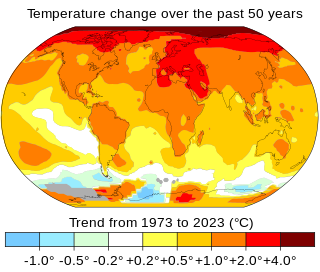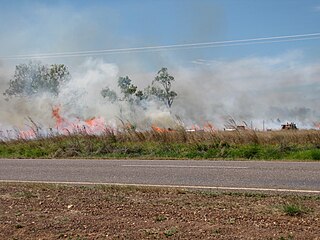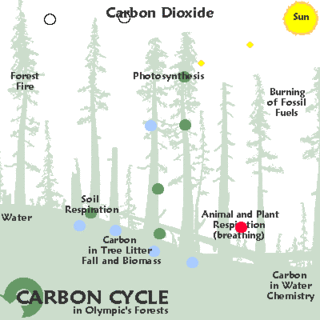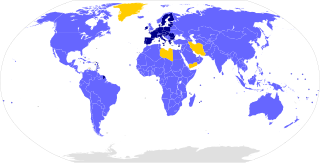Environmental finance is a field within finance that employs market-based environmental policy instruments to improve the ecological impact of investment strategies. The primary objective of environmental finance is to regress the negative impacts of climate change through pricing and trading schemes.The field of environmental finance was established in response to the poor management of economic crises by government bodies globally. Environmental finance aims to reallocate a businesses resources to improve the sustainability of investments whilst also retaining profit margins.

There is currently a strong scientific consensus that the Earth is warming and that this warming is mainly caused by human activities. This consensus is supported by various studies of scientists' opinions and by position statements of scientific organizations, many of which explicitly agree with the Intergovernmental Panel on Climate Change (IPCC) synthesis reports.
Climate engineering or climate intervention, commonly referred to as geoengineering, is the deliberate and large-scale intervention in the Earth's climate system. The most prominent subcategories of climate engineering are solar radiation management and carbon dioxide removal. Solar radiation management refers to offsetting the warming effect of greenhouse gases by reflecting more solar radiation (sunlight) back into space. Carbon dioxide removal refers to removing carbon dioxide gas from the atmosphere and sequestering it for long periods of time.

Climate change mitigation consists of actions to limit the magnitude or rate of global warming and its related effects. This generally involves reductions in human emissions of greenhouse gases (GHGs).

The complex politics of global warming results from numerous cofactors arising from the global economy's dependence on carbon dioxide emitting fossil fuels; and because greenhouse gases such as CO
2, methane and N
2O cause global warming.
- Implications to all aspects of a nation-state's economy: The vast majority of the world economy relies on energy sources or manufacturing techniques that release greenhouse gases at almost every stage of production, transportation, storage, delivery & disposal while a consensus of the world's scientists attribute global warming to the release of CO
2 and other greenhouse gases. This intimate linkage between global warming and economic vitality implicates almost every aspect of a nation-state's economy; - Industrialization of the developing world: As developing nations industrialize their energy needs increase and since conventional energy sources produce CO
2, the CO
2 emissions of developing countries are beginning to rise at a time when the scientific community, global governance institutions and advocacy groups are telling the world that CO
2 emissions should be decreasing. - Metric selection (transparency) and perceived responsibility / ability to respond: Among the countries of the world, disagreements exist over which greenhouse gas emission metrics should be used like total emissions per year, per capita emissions per year, CO2 emissions only, deforestation emissions, livestock emissions or even total historical emissions. Historically, the release of CO
2 has not been even among all nation-states, and nation-states have challenges with determining who should restrict emissions and at what point of their industrial development they should be subject to such commitments; - Vulnerable developing countries and developed country legacy emissions: Some developing nations blame the developed world for having created the global warming crisis because it was the developed countries that emitted most of the CO
2 over the twentieth century and vulnerable countries perceive that it should be the developed countries that should pay to fix the problem; - Consensus-driven global governance models: The global governance institutions that evolved during the 20th century are all consensus driven deliberative forums where agreement is difficult to achieve and even when agreement is achieved it is almost impossible to enforce;
- Well organized and funded special-interest lobbying bodies: Special interest lobbying by well organized groups, such as the fossil fuels lobby, distort and amplify aspects of the challenge.
The economics of climate change concerns the economic aspects of climate change; this can inform policies that governments might consider in response. A number of factors make this and the politics of climate change a difficult problem: it is a long-term, intergenerational problem; benefits and costs are distributed unequally both within and across countries; and both scientific and public opinions need to be taken into account.

Climate change includes both the global warming driven by human emissions of greenhouse gases, and the resulting large-scale shifts in weather patterns. Though there have been previous periods of climatic change, since the mid-20th century, humans have had unprecedented impact on Earth's climate system and caused change on a global scale.
A low-carbon economy (LCE), low-fossil-fuel economy (LFFE), or decarbonised economy is an economy based on low-carbon power sources that therefore has a minimal output of greenhouse gas (GHG) emissions into the atmosphere, specifically carbon dioxide. GHG emissions due to anthropogenic (human) activity are the dominant cause of observed global warming since the mid-20th century. Continued emission of greenhouse gases may cause long-lasting changes around the world, increasing the likelihood of severe, pervasive, and irreversible effects for people and ecosystems.

Climate change in Australia has been a critical issue since the beginning of the 21st century. Australia is becoming hotter, and more prone to extreme heat, bushfires, droughts, floods and longer fire seasons because of climate change. Since the beginning of the 20th century Australia has experienced an increase of nearly 1 °C in average annual temperatures, with warming occurring at twice the rate over the past 50 years than in the previous 50 years. Recent climate events such as extremely high temperatures and widespread drought have focused government and public attention on the impacts of climate change in Australia. Rainfall in southwestern Australia has decreased by 10–20% since the 1970s, while southeastern Australia has also experienced a moderate decline since the 1990s. Rainfall is expected to become heavier and more infrequent, as well as more common in summer rather than in winter. Water sources in the southeastern areas of Australia have depleted due to increasing population in urban areas coupled with persistent prolonged drought.

Professor Ross Garnaut led two climate change reviews, the first commencing in 2007 and the second in 2010.
This is a list of climate change topics.

Climate change in Massachusetts will affect both urban and rural environments, including forestry, fisheries, agriculture, and coastal development. The Northeast is projected to warm faster than global average temperatures; by 2035, the Northeast is "projected to be more than 3.6°F (2°C) warmer on average than during the preindustrial era."

Australia has one of the highest per capita emissions of greenhouse gas in the world, with its 0.3% of the world's population releasing 1.07% of the world's greenhouse gases. Emissions per capita for Australia are still well above the OECD, and developed world average, with most sources pointing to 22-25 tons. Australia uses principally coal power (70%) for electricity but this is decreasing with a growing share of renewables making up the energy supply mix. Emissions by the country have started to fall and are expected to continue to fall in coming years as more projects come online.
Australia is well placed to harness solar thermal energy. Solar thermal energy is used in three main ways: solar hot water heating, production of steam for electricity generation and space heating through building design.

Biosequestration is the capture and storage of the atmospheric greenhouse gas carbon dioxide by continual or enhanced biological processes.
The Chicago Climate Action Plan (CCAP) is Chicago's climate change mitigation and adaptation strategy that was adopted in September 2008. The CCAP has an overarching goal of reducing Chicago's greenhouse gas emissions to 80 percent below 1990 levels by 2050, with an interim goal of 25 percent below 1990 levels by 2020.

The Paris Agreement is an agreement within the United Nations Framework Convention on Climate Change (UNFCCC), dealing with greenhouse-gas-emissions mitigation, adaptation, and finance, signed in 2016. The agreement's language was negotiated by representatives of 196 state parties at the 21st Conference of the Parties of the UNFCCC in Le Bourget, near Paris, France, and adopted by consensus on 12 December 2015. As of December 2020, all 197 members of the UNFCCC have signed the agreement and 189 remain party to it. Of the eight countries which are not party to the law, the only significant emitters are Iran and the United States.

The Climate and Clean Air Coalition to Reduce Short-Lived Climate Pollutants (CCAC) was launched by the United Nations Environment Programme (UNEP) and six countries — Bangladesh, Canada, Ghana, Mexico, Sweden, and the United States — on 16 February 2012. The CCAC aims to catalyze rapid reductions in short-lived climate pollutants to protect human health, agriculture and the environment. To date, more than $47 million has been pledged to the Climate and Clean Air Coalition from Canada, Denmark, the European Commission, Germany, Japan, the Netherlands, Norway, Sweden, and the United States. The program is managed out of the United Nations Environmental Programme through a Secretariat in Paris, France.

Climate change has worsened at the hands of human activity for centuries, and many scientific efforts have been made since the first political acknowledgment. In order to avoid the ongoing and potential impacts of climate change, mitigation technologies have been developed in order to adapt to the issue, each invention belonging to one of four specific groups of effort. These groups include energy efficiency improvements, renewable energy (RE), nuclear power/energy (NE), and carbon capture storage (CCS). However, concerns regarding mitigating and adapting to climate change commonly have a priority focus on the groups of carbon capture storage and renewable energy efforts.
The history of climate change policy and politics refers to the continuing history of political actions, policies, trends, controversies and activist efforts as they pertain to the issue of global warming and other environmental anomalies. Dryzek, Norgaard, and Schlosberg suggest that critical reflection on the history of climate policy is necessary because it provides 'ways to think about one of the most difficult issues we human beings have brought upon ourselves in our short life on the planet’.













